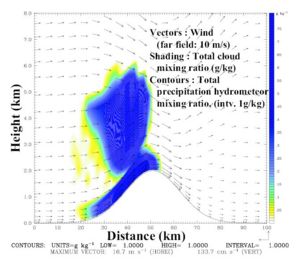Difference between revisions of "MM5V3 WIDEALGRID package for Idealized Simulations"
m (Text replace - '<pre>' to ' <pre>') |
|||
| (17 intermediate revisions by the same user not shown) | |||
| Line 1: | Line 1: | ||
== | [[Image:MM5_Widealgrid.jpg|thumb|right|300px]] | ||
[[wikipedia:MM5|MM5]] is a popular, modern [[wikipedia:Limited Area Atmospheric Model]] maintained by [[wikipedia:National Center for Atmospheric Research]], CO, USA. This model is geared towards operational and research simulations of actual atmosphere. Sometimes it is useful to have the ability to define hypothetical conditions under which the model should operate. However, this is not a standard feature of the model. There are several solutions for this problem, proposed by various people. I have been using th e [http://www.vedur.is/~folk/olafurr/idealgrid/index.html Idealgrid package] during 2002. Later, I needed to add moisture fields to the idealized conditions, which was not possible to do with the original Idealgrid. Therefore I hacked Idealgrid, added a new landform and landuse generation module (it was not available in Idealgrid), renamed as ''widealgrid'' (wet-idealgrid) and used for my research work during 2004-2006. | ==Introduction== | ||
[[wikipedia:MM5|MM5]] is a popular, modern [[wikipedia:Limited Area Atmospheric Model|Limited Area Atmospheric Model]] maintained by [[wikipedia:National Center for Atmospheric Research|National Center for Atmospheric Research]], CO, USA. This model is geared towards operational and research simulations of actual atmosphere. Sometimes it is useful to have the ability to define hypothetical conditions under which the model should operate. However, this is not a standard feature of the model. There are several solutions for this problem, proposed by various people. I have been using th e [http://www.vedur.is/~folk/olafurr/idealgrid/index.html Idealgrid package] during 2002. Later, I needed to add moisture fields to the idealized conditions, which was not possible to do with the original Idealgrid. Therefore I hacked Idealgrid, added a new landform and landuse generation module (it was not available in Idealgrid), renamed as ''widealgrid'' (wet-idealgrid) and used for my research work during 2004-2006. | |||
==Important Note== | |||
(16:28, 13 April 2006 (JST)) | |||
The offspring of MM5, the [[wikipedia:WRF model|WRF model]] has a standard idealized simulation component [[http://www.mmm.ucar.edu/wrf/users/]. Therefore, it is advisable to check the abilities of WRF ideal module before plunging into widealgrid package, unless there is an absolute need to use MM5 for ideal simulations. | |||
==Package== | ==Package== | ||
<br> | <br> | ||
Download from [[:Image:Widealgrid.tar.bz2|here]]. (You need [[wikipedia:bzip2|bzip2]] | Download the package from [[:Image:Widealgrid.tar.bz2|here]]. (You need [[wikipedia:bzip2|bzip2]] | ||
to expand it)<br> | to expand it). Expand and then untar the file. | ||
bunzip2 Widealgrid.tar.bz | |||
tar -xvf Widealgrid.tar.bz | |||
You get two files: <br> | |||
terrainMake.tar & widealgrid.tar | |||
Untar at the target regridder directory< | ;terrainMake: Untar the file,<nowiki> | ||
</nowiki> | |||
widealgrid folder with a number of files | <pre><nowiki> | ||
a new namelist.input file. | tar -xvf terrainMake.tar | ||
</nowiki></pre> then read the README file inside. The package is written in [[wikipedia:Java Language|Java Language]], so you need a java compiler (a standard component of [[wikipedia:Linux|Linux]] thesedays) | |||
to run it. | |||
;widealgrid: Untar at the target regridder directory. <nowiki> | |||
</nowiki> | |||
<pre><nowiki> | |||
cd ./REGRID/regridder | |||
tar -xvf widealgrid.tar | |||
</nowiki></pre>widealgrid folder with a number of files and a a new namelist.input file (meaning it will replace your original namelist.input in ./REGRID/regridder !). | |||
Enjoy! <br> | Enjoy! <br> | ||
<br> | <br> | ||
You may want to read our recent paper. ( | You may want to read our recent paper. (This is the standard reference for widealgrid widealgrid). <br> | ||
<span style="line-height: 20px;"> | <span style="line-height: 20px;"> | ||
<p style="line-height: 20px;"> </p> | <p style="line-height: 20px;"> </p> | ||
</span> | </span> | ||
[ | ==References== | ||
[http://www.atmos-chem-phys.net/5/215/2005/ A. Pathirana, S. Herath and T. Yamada, Simulating orographic rainfall with a limited-area, non-hydrostatic atmospheric model under idealized forcing, Atmos. Chem. Phys., 5, 215-226, 2005] | |||
with a limited-area, non-hydrostatic atmospheric model under idealized forcing, | |||
[[Category:Hydrology-Meteorology]] | |||
Chem. Phys., 5, 215-226, 2005 | |||
Latest revision as of 19:11, 2 October 2009
Introduction
MM5 is a popular, modern Limited Area Atmospheric Model maintained by National Center for Atmospheric Research, CO, USA. This model is geared towards operational and research simulations of actual atmosphere. Sometimes it is useful to have the ability to define hypothetical conditions under which the model should operate. However, this is not a standard feature of the model. There are several solutions for this problem, proposed by various people. I have been using th e Idealgrid package during 2002. Later, I needed to add moisture fields to the idealized conditions, which was not possible to do with the original Idealgrid. Therefore I hacked Idealgrid, added a new landform and landuse generation module (it was not available in Idealgrid), renamed as widealgrid (wet-idealgrid) and used for my research work during 2004-2006.
Important Note
(16:28, 13 April 2006 (JST)) The offspring of MM5, the WRF model has a standard idealized simulation component [[1]. Therefore, it is advisable to check the abilities of WRF ideal module before plunging into widealgrid package, unless there is an absolute need to use MM5 for ideal simulations.
Package
Download the package from here. (You need bzip2
to expand it). Expand and then untar the file.
bunzip2 Widealgrid.tar.bz tar -xvf Widealgrid.tar.bz
You get two files:
terrainMake.tar & widealgrid.tar
- terrainMake
- Untar the file,
tar -xvf terrainMake.tar
then read the README file inside. The package is written in Java Language, so you need a java compiler (a standard component of Linux thesedays)
to run it.
- widealgrid
- Untar at the target regridder directory.
cd ./REGRID/regridder tar -xvf widealgrid.tar
widealgrid folder with a number of files and a a new namelist.input file (meaning it will replace your original namelist.input in ./REGRID/regridder !).
Enjoy!
You may want to read our recent paper. (This is the standard reference for widealgrid widealgrid).
